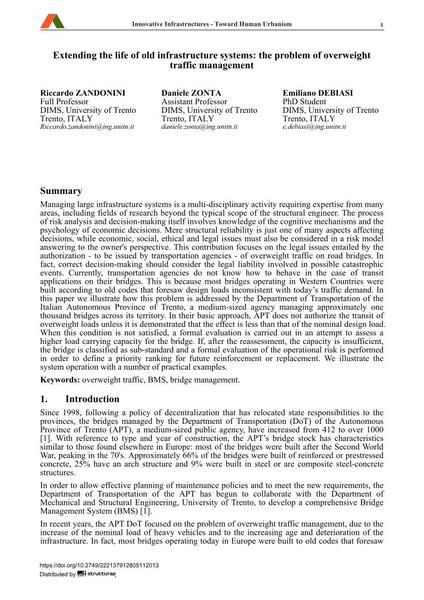Extending the life of old infrastructure systems: the problem of overweight traffic management

|
|
|||||||||||
Bibliografische Angaben
| Autor(en): |
Riccardo Zandonini
Daniele Zonta Emiliano Debiasi |
||||
|---|---|---|---|---|---|
| Medium: | Tagungsbeitrag | ||||
| Sprache(n): | Englisch | ||||
| Tagung: | 18th IABSE Congress: Innovative Infrastructures – Towards Human Urbanism, Seoul, Korea, 19-21 September 2012 | ||||
| Veröffentlicht in: | IABSE Congress Seoul 2012 | ||||
|
|||||
| Seite(n): | 1444-1451 | ||||
| Anzahl der Seiten (im PDF): | 8 | ||||
| DOI: | 10.2749/222137912805112013 | ||||
| Abstrakt: |
Managing large infrastructure systems is a multi-disciplinary activity requiring expertise from many areas, including fields of research beyond the typical scope of the structural engineer. The process of risk analysis and decision-making itself involves knowledge of the cognitive mechanisms and the psychology of economic decisions. Mere structural reliability is just one of many aspects affecting decisions, while economic, social, ethical and legal issues must also be considered in a risk model answering to the owner's perspective. This contribution focuses on the legal issues entailed by the authorization - to be issued by transportation agencies - of overweight traffic on road bridges. In fact, correct decision-making should consider the legal liability involved in possible catastrophic events. Currently, transportation agencies do not know how to behave in the case of transit applications on their bridges. This is because most bridges operating in Western Countries were built according to old codes that foresaw design loads inconsistent with today’s traffic demand. In this paper we illustrate how this problem is addressed by the Department of Transportation of the Italian Autonomous Province of Trento, a medium-sized agency managing approximately one thousand bridges across its territory. In their basic approach, APT does not authorize the transit of overweight loads unless it is demonstrated that the effect is less than that of the nominal design load. When this condition is not satisfied, a formal evaluation is carried out in an attempt to assess a higher load carrying capacity for the bridge. If, after the reassessment, the capacity is insufficient, the bridge is classified as sub-standard and a formal evaluation of the operational risk is performed in order to define a priority ranking for future reinforcement or replacement. We illustrate the system operation with a number of practical examples. |
||||
| Stichwörter: |
Brückenmanagement
|
||||
